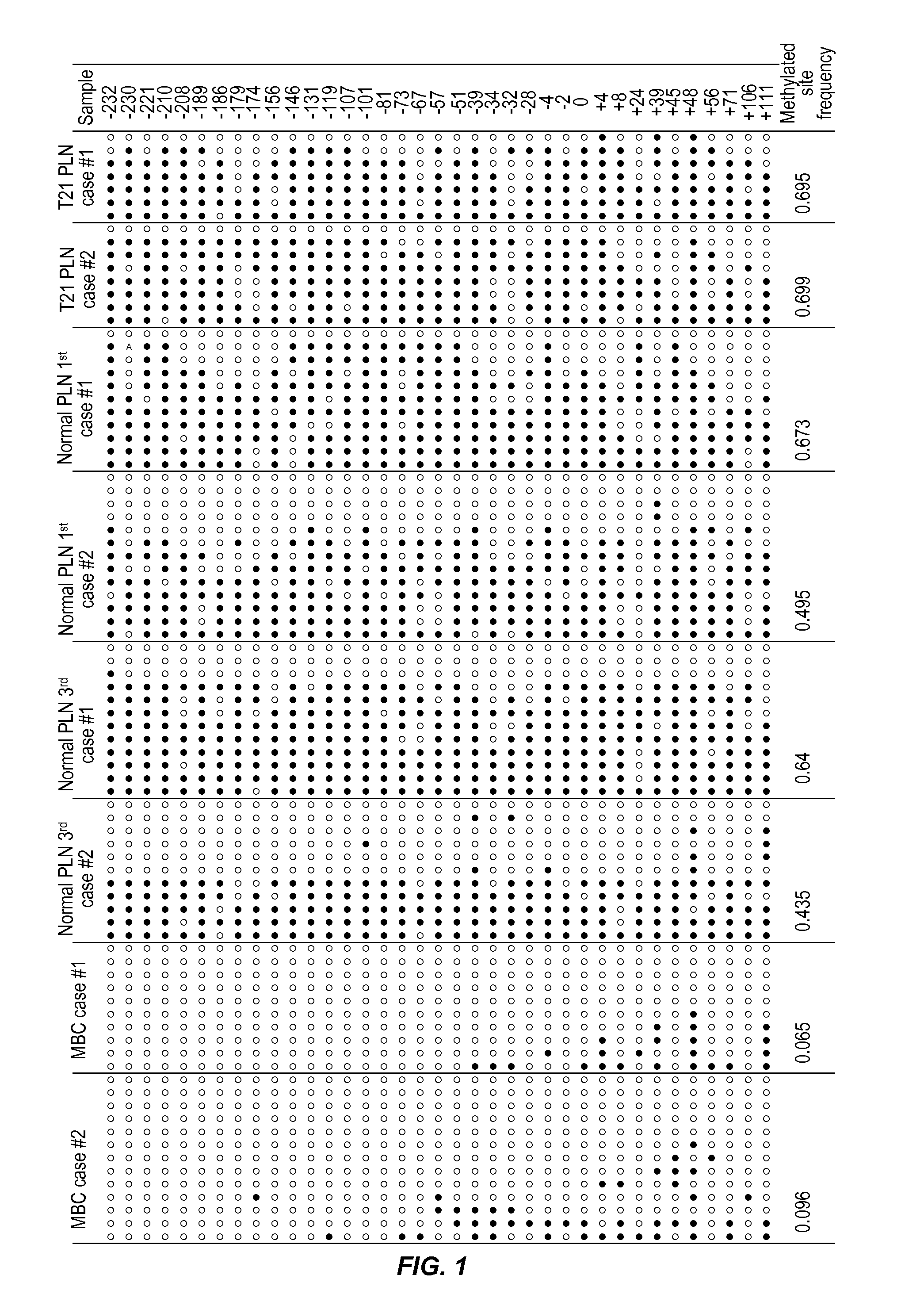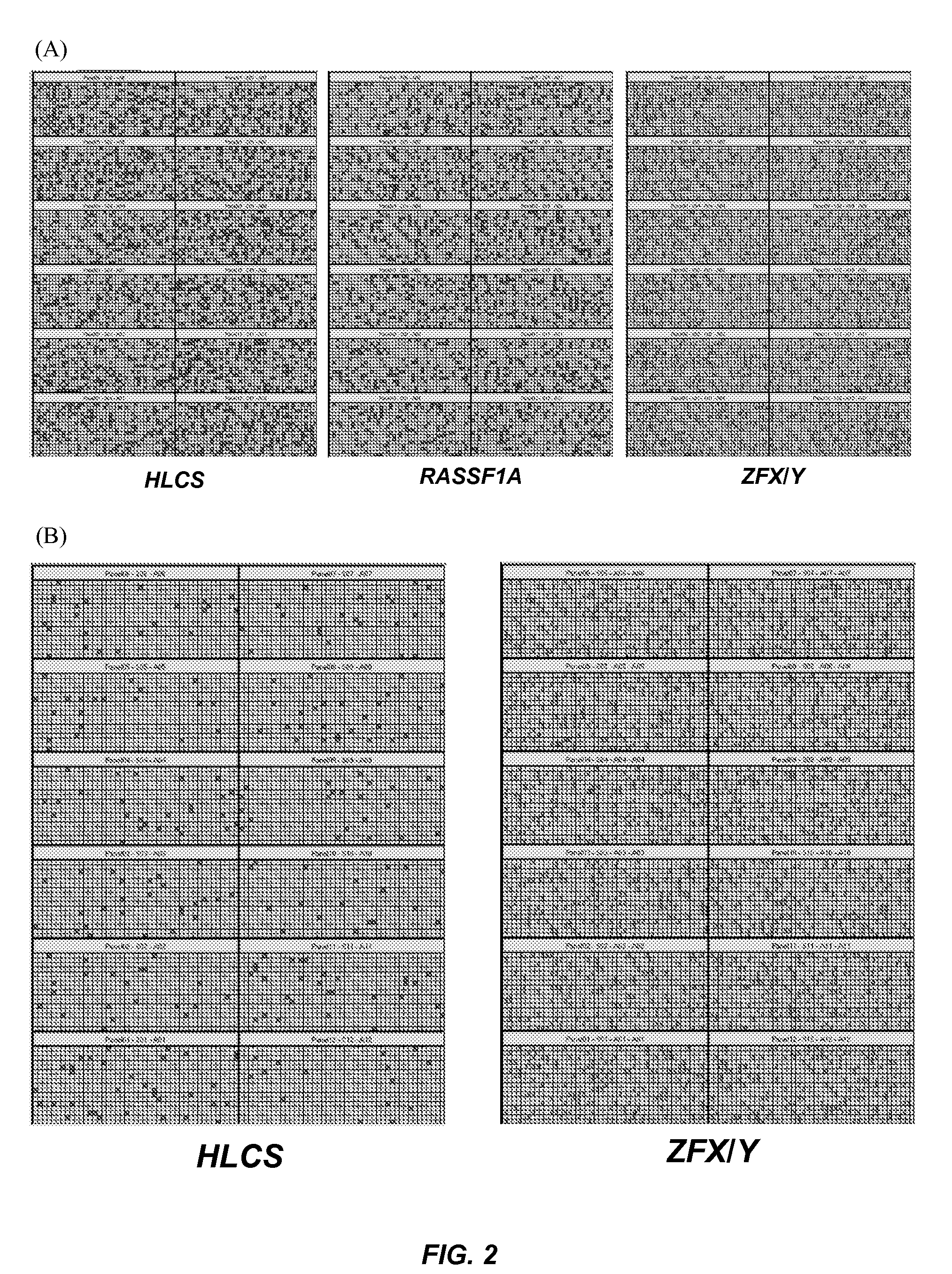Method for detecting chromosomal aneuploidy
a chromosomal aneuploidy and chromosomal aneuploidy technology, applied in the field of chromosomal aneuploidy detection, can solve problems such as carrying the risk of unintended loss of fetus or miscarriag
- Summary
- Abstract
- Description
- Claims
- Application Information
AI Technical Summary
Benefits of technology
Problems solved by technology
Method used
Image
Examples
example 1
I. Materials and Methods
Study Participants
[0094]Women with euploid and trisomy 21 pregnancies who attended the Department of Obstetrics and Gynaecology, Prince of Wales Hospital, Hong Kong, were recruited. Informed consent was obtained from individuals who joined the study, and ethics approval was obtained from the Joint Chinese University of Hong Kong—New Territories East Cluster Clinical Research Ethical Committee.
Screening of Differentially-Methylated Regions on Chromosome 21 By Cobra
[0095]COBRA (Xiong and Laird, Nucleic Acids Res 1997; 25:2532-4) was used to assess the methylation status of genomic sequences on chromosome 21 in DNA samples from placentas and maternal blood cells.
Cloning and Bisulfite Sequencing Analysis of the Differentially-Methylated Locus Identified by Cobra
[0096]PCR products from the COBRA analysis were used for cloning and bisulfite sequencing. To analyze methylation status at the resolution of a single molecule, the PCR product was TA-cloned into a plasmid...
example 2
[0133]A novel epigenetic-genetic chromosome dosage approach is recently developed for fetal trisomy 21 detection using a fetal epigenetic marker, the putative promoter of holocarboxylase synthetase (HLCS) on chromosome 21, and a fetal genetic marker, the zinc finger protein, Y-linked (ZFY) gene present on chromosome Y (Tong et al., Clin Chem 2010; 56:90-8). To demonstrate that this method can be used for the detection of both male and female fetuses, the inventors have explored the use of a paternally-inherited fetal single nucleotide polymorphism (SNP) allele on a reference chromosome to serve as the baseline for epigenetic-genetic chromosome 21 dosage determination in place of the chromosome Y marker.
I. Materials and Methods
Study Participants
[0134]Women with euploid and trisomy 21 (T21) pregnancies who attended the Department of Obstetrics and Gynaecology, Prince of Wales Hospital were recruited between October 2009 and March 2010. Informed consent was obtained from individuals wh...
example 3
Epigenetic-Genetic Chromosome Dosage Approach for the Detection of Fetal Trisomy 18
[0172]This example demonstrates the application of epigenetic-genetic (EGG) chromosome dosage approach for the detection of fetal trisomy 18 (T18). This example of the EGG approach involved a fetal epigenetic marker located on chromosome 18 and a fetal genetic marker located on a reference chromosome, respectively, in maternal plasma. The fetal epigenetic marker is, preferably, Marker 18A [genomic location chr18:10022533-10022724, defined according to the Human Genome March 2006 Assembly (hg18)], which is a 146-bp intergenic region located 75 kb downstream of the gene VAPA (vesicle-associated membrane protein)-associated protein A) and 421 kb upstream of the gene APCDD1 (adenomatosis polyposis coli down-regulated 1), as identified by an methylated DNA immunoprecipitation and tiling array analysis (described in U.S. Ser. No. 61 / 308,578). However, this fetal epigenetic marker can also be any cytosine-co...
PUM
| Property | Measurement | Unit |
|---|---|---|
| temperature | aaaaa | aaaaa |
| temperature | aaaaa | aaaaa |
| volume | aaaaa | aaaaa |
Abstract
Description
Claims
Application Information
 Login to View More
Login to View More - R&D
- Intellectual Property
- Life Sciences
- Materials
- Tech Scout
- Unparalleled Data Quality
- Higher Quality Content
- 60% Fewer Hallucinations
Browse by: Latest US Patents, China's latest patents, Technical Efficacy Thesaurus, Application Domain, Technology Topic, Popular Technical Reports.
© 2025 PatSnap. All rights reserved.Legal|Privacy policy|Modern Slavery Act Transparency Statement|Sitemap|About US| Contact US: help@patsnap.com



